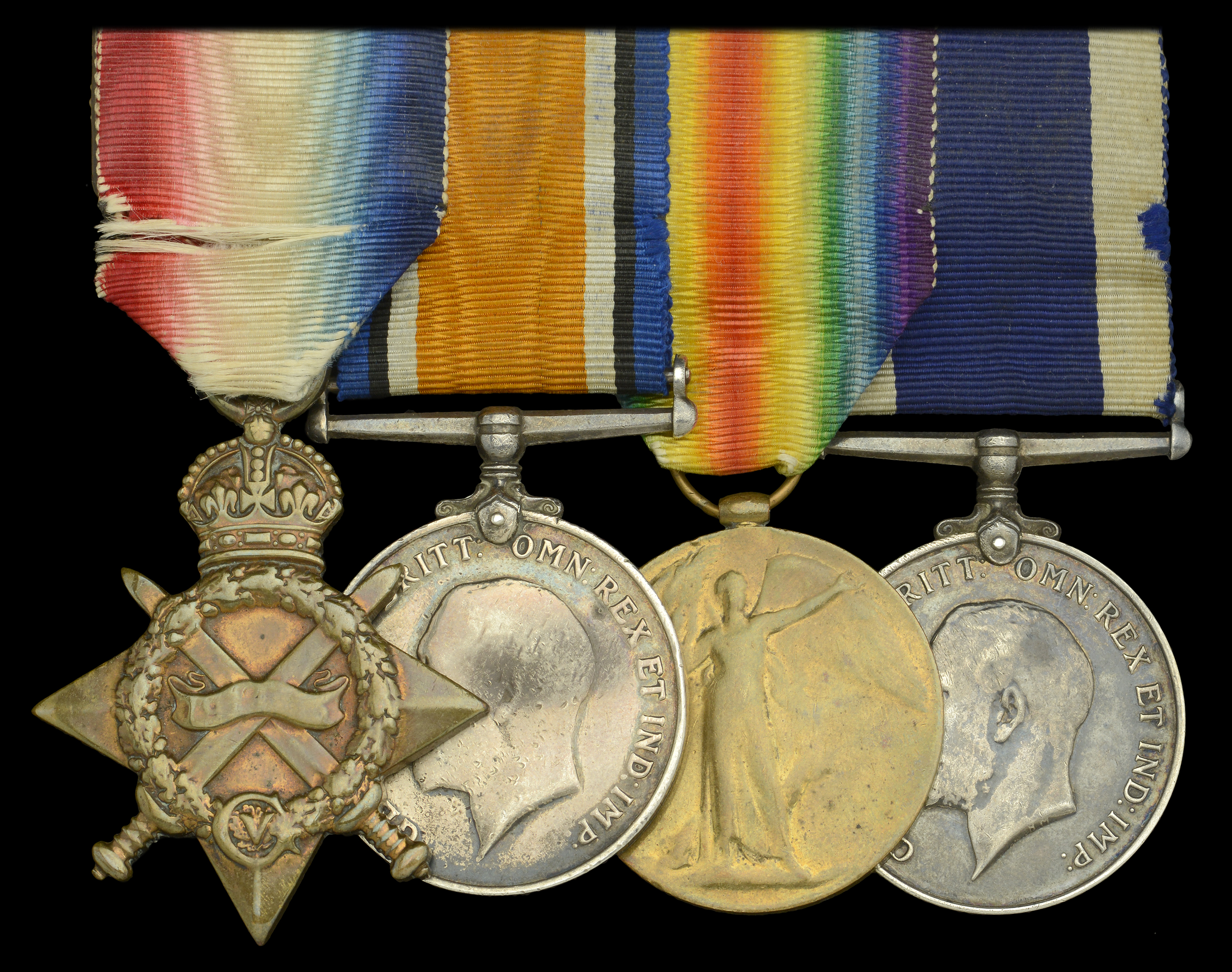119
Four: Acting Petty Officer S. G. Thompson, Royal Navy, who served in H.M.S. Colossus at the...
Bids do not include VAT, buyer’s premium or delivery.
By confirming your bid, you agree that you have read and accepted the-saleroom.com and the auctioneer's terms and conditions. Confirming your bid is a legally binding obligation to purchase and pay for the lot should your bid be successful.
Choose one of the quick bid options below:
Bids do not include VAT, buyer’s premium or delivery.
By confirming your bid, you agree that you have read and accepted the-saleroom.com and the auctioneer's terms and conditions. Confirming your bid is a legally binding obligation to purchase and pay for the lot should your bid be successful.
1914-15 Star (J.33328, S. G. Thompson. Boy. 1., R.N.); British War and Victory Medals (J.33328. S. G. Thompson. A.B. R.N.); Royal Navy L.S. & G.C., G.V.R., 3rd issue, coinage head (J.33328 S. G. Thompson. A.B. H.M.S. Danae.) mounted as worn, heavily polished and worm, therefore fair, the naming all completely legible (4) £240-£280
---
Samuel George Thompson was Scariff, County Clare, Ireland ,on 28 January 1899 and joined the Royal Navy as a Boy Second Class on 29 November 1914, and served during the Great War in a variety of ships and shore based establishments, most notably H.M.S. Colossus from 26 August 1915 to 21 October 1918; he was present in her at the Battle of Jutland, 31 May 1916, where she was the only dreadnought from the main body of the Grand Fleet to be hit during the Battle. Advanced Able Seaman on 25 March 1917, Thompson remained in the service following the cessation of hostilities, and was awarded his Long Service and Good Conduct Medal on 26 February 1932. Advanced Leading Seaman on 1 September 1936, he was posted to the newly-built destroyer H.M.S. Hunter on 5 October 1936, which sailed to join the Mediterranean Fleet that same month.
In May 1937, Hunter was designated as part of Britain’s contribution to the League of Nations Arms Blockade and Non-Intervention Patrols, intended to help end the Spanish Civil War between the left-wing Republican government and General Franco’s fascist Nationalists, who were supplied by Germany and Italy. Stationed off the Republican-held port of Almeria in Southern Spain, Hunter’s captain, Lieutenant-Commander B. G. Scurfield, later wrote: ‘There are alleged to be mines in the shallower water near the shore, so our orders are to remain outside the 100 fathoms line. And so, we just lie stopped in the middle of the bay about five miles from the shore… Whenever we see an aeroplane we close up at anti-aircraft stations.’
On Thursday 13 May 1937, Hunter lay stationary at her normal location; there was a breeze and a slight swell. At about 2.15 pm there was a terrific blast as a Nationalist naval mine detonated against her hull. Water mixed with fuel oil, flames and steam shot into the air on the port side between the bridge and the foremost funnel. All the lights went out and everything was drenched with oil. The forward boiler-room, which had been steaming to provide electricity and to enable the ship to get underway quickly if required, was a mass of twisted steel and the floor of the galley above it had disappeared, with the cook falling into the wreckage below. Commander Scurfield jumped into the smoke, oil and fumes, reached the stricken man, who had lost a foot and was trapped by debris. As described by eye-witnesses, ‘he worked like a madman, pulled the obstructions away and hauled the cook out by sheer strength and clambered up with him.’ Moving forwards along the ship, which was listing to starboard and sinking by the bows, he heard cries from a hatch leading to the mess deck below. The ladder had vanished, so ‘With no knowledge of the damage that had been done to the deck and with complete disregard of his own safety, he jumped down below.’ After pulling men out of the darkness of the Torpedomen’s messdeck, flooded with several feet of fuel oil and with naked flames in close proximity, he ‘entered the Stoker Petty Officers’ mess, the floor of which was, as I saw afterwards, more than half blown away. Had he trodden on any of the missing part he would have undoubtedly have joined the other victims. He rescued altogether from these two messdecks about ten or twelve men who, had it not been for his prompt action, would undoubtedly have died.’ Towed into Almeria, the Hunter suffered a total of eight men killed and fourteen were hospitalised. For his great gallantry, Lieutenant-Commander Scurfield was awarded the Albert Medal.
Thompson was amongst those wounded, and on 3 June 1937 underwent an operation to amputate his left leg. ‘Commended by their Lordships for fortitude and meritorious service when H.M.S. Hunter was mined off the Coast of Spain on 13 May 1937’ (Recipient’s record of service refers) and appointed Acting Petty Officer that same day, he was shore invalided, Permanently Unfit for Naval Service, on 16 March 1938.
Sold with copied record of service.
1914-15 Star (J.33328, S. G. Thompson. Boy. 1., R.N.); British War and Victory Medals (J.33328. S. G. Thompson. A.B. R.N.); Royal Navy L.S. & G.C., G.V.R., 3rd issue, coinage head (J.33328 S. G. Thompson. A.B. H.M.S. Danae.) mounted as worn, heavily polished and worm, therefore fair, the naming all completely legible (4) £240-£280
---
Samuel George Thompson was Scariff, County Clare, Ireland ,on 28 January 1899 and joined the Royal Navy as a Boy Second Class on 29 November 1914, and served during the Great War in a variety of ships and shore based establishments, most notably H.M.S. Colossus from 26 August 1915 to 21 October 1918; he was present in her at the Battle of Jutland, 31 May 1916, where she was the only dreadnought from the main body of the Grand Fleet to be hit during the Battle. Advanced Able Seaman on 25 March 1917, Thompson remained in the service following the cessation of hostilities, and was awarded his Long Service and Good Conduct Medal on 26 February 1932. Advanced Leading Seaman on 1 September 1936, he was posted to the newly-built destroyer H.M.S. Hunter on 5 October 1936, which sailed to join the Mediterranean Fleet that same month.
In May 1937, Hunter was designated as part of Britain’s contribution to the League of Nations Arms Blockade and Non-Intervention Patrols, intended to help end the Spanish Civil War between the left-wing Republican government and General Franco’s fascist Nationalists, who were supplied by Germany and Italy. Stationed off the Republican-held port of Almeria in Southern Spain, Hunter’s captain, Lieutenant-Commander B. G. Scurfield, later wrote: ‘There are alleged to be mines in the shallower water near the shore, so our orders are to remain outside the 100 fathoms line. And so, we just lie stopped in the middle of the bay about five miles from the shore… Whenever we see an aeroplane we close up at anti-aircraft stations.’
On Thursday 13 May 1937, Hunter lay stationary at her normal location; there was a breeze and a slight swell. At about 2.15 pm there was a terrific blast as a Nationalist naval mine detonated against her hull. Water mixed with fuel oil, flames and steam shot into the air on the port side between the bridge and the foremost funnel. All the lights went out and everything was drenched with oil. The forward boiler-room, which had been steaming to provide electricity and to enable the ship to get underway quickly if required, was a mass of twisted steel and the floor of the galley above it had disappeared, with the cook falling into the wreckage below. Commander Scurfield jumped into the smoke, oil and fumes, reached the stricken man, who had lost a foot and was trapped by debris. As described by eye-witnesses, ‘he worked like a madman, pulled the obstructions away and hauled the cook out by sheer strength and clambered up with him.’ Moving forwards along the ship, which was listing to starboard and sinking by the bows, he heard cries from a hatch leading to the mess deck below. The ladder had vanished, so ‘With no knowledge of the damage that had been done to the deck and with complete disregard of his own safety, he jumped down below.’ After pulling men out of the darkness of the Torpedomen’s messdeck, flooded with several feet of fuel oil and with naked flames in close proximity, he ‘entered the Stoker Petty Officers’ mess, the floor of which was, as I saw afterwards, more than half blown away. Had he trodden on any of the missing part he would have undoubtedly have joined the other victims. He rescued altogether from these two messdecks about ten or twelve men who, had it not been for his prompt action, would undoubtedly have died.’ Towed into Almeria, the Hunter suffered a total of eight men killed and fourteen were hospitalised. For his great gallantry, Lieutenant-Commander Scurfield was awarded the Albert Medal.
Thompson was amongst those wounded, and on 3 June 1937 underwent an operation to amputate his left leg. ‘Commended by their Lordships for fortitude and meritorious service when H.M.S. Hunter was mined off the Coast of Spain on 13 May 1937’ (Recipient’s record of service refers) and appointed Acting Petty Officer that same day, he was shore invalided, Permanently Unfit for Naval Service, on 16 March 1938.
Sold with copied record of service.
Orders, Decorations, Medals and Militaria
Sale Date(s)
Venue Address
General delivery information available from the auctioneer
If you are successful in purchasing lot/s being auctioned by us and opt for the item/s to be sent to you, we will use the following methods of shipment:
Within the UK
If you live within the UK, items will be despatched using Royal Mail Special Delivery. This service provides parcel tracking (via the Royal Mail website) and next weekday delivery (betwen 9am and 1pm). Items delivered within the UK are covered by our insurance company. Heavy and bulky lots will be sent by courier, in discussion with the client.
Outside of the UK
If the item/s being sent are worth under £1000 in total they are sent using Royal Mail’s Signed For International service. This ensures the item must be signed for when it is delivered.
If the item/s being sent are valued at over £1000 in total they will be sent using FedEx. This service allows next day delivery to customers in many parts of the US and parcels are fully trackable using the FedEx website.
Shipping Exceptions
Certain lots such as those containing glass or sharp implements, etc., may not be suitable for in-house shipping within or outside of the UK. Please contact Noonans with any queries.
Important Information
Auctioneer's Buyers Premium: 24% (+VAT)
There is an additional charge of 4.95% (+VAT/sales tax)










